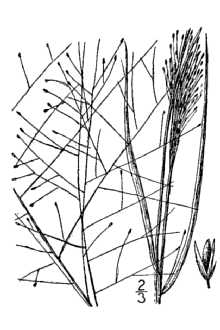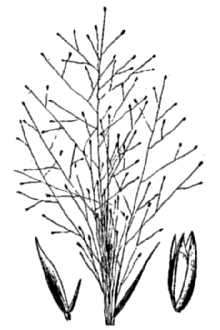Texas Dropseed
Scientific Name: Sporobolus texanus Vasey

| General Information | |
|---|---|
| Usda Symbol | SPTE5 |
| Group | Monocot |
| Life Cycle | Perennial |
| Growth Habits | Graminoid |
| Native Locations | SPTE5 |
Plant Guide
Use a soil moisture meter to monitor the soil moisture where Texas Dropseed is planted.
Fact Sheet
Uses
Revegetation: Texas dropseed has the ability to tolerate higher levels of salinity and alkalinity in the soil. It can be used to revegetate areas such as oil well pads and on other saline soils. Erosion Control: Texas dropseed is a bunchgrass with very thick vegetation near the soil surface which can be used to stabilize soils that have a tendency to erode. Wildlife: Texas dropseed provides dense cover for birds and small mammals. The foliage is browsed by deer and small mammals. The seed can be eaten by birds and small mammals.
Status
Please consult the PLANTS Web site (http://plants.usda.gov) and your State Department of Natural Resources for this plant’s current status (e.g. threatened or endangered species, state noxious status, and wetland indicator values).
Weediness
This plant may become weedy or invasive in some regions or habitats and may displace desirable vegetation if not properly managed. Please consult your local NRCS Field Office, Cooperative Extension Service office, state natural resource, or state agriculture department regarding its status and use. Weed information is also available from the PLANTS Web site at http://www.plants.usda.gov. Please consult this and Related Web Sites and view the plant profile for this species for further information.
Description
Texas dropseed is a warm-season perennial bunchgrass that grows close to the soil surface. The culms of the plant range from twelve to twenty inches long. The leaf blades range from 1 ½ to 5 inches long and less than 1 ½ inches wide. They are smooth on the bottom side, but scabrous on the top. The seed head is a panicle-type with many spreading branches and branchlets. The seed head is between four to twelve inches long and almost the same wide. Once the seed matures, from June to August, the seed head breaks away from the plant.
Adaptation
Texas dropseed is found from Texas north to Nebraska, and west from Utah to Arizona. The plant is adapted to soils with higher saline and alkaline levels. Distribution: Please consult the Plant Profile page for this species on the PLANTS Web site.
Establishment
Texas dropseed should be planted on a clean, firm seedbed. Planting can be done using either a grass drill or broadcast seeding. Seed is planted less than ½ inch deep at a rate of 1.0 lbs pure live seed (pls) per acre. When planting this as a component of a seed mixture, the seeding rate should be adjusted to the desired percent of the mix. Soil samples should be taken before planting to determine the amount of fertilizer needed to bring the fertility level up to a medium range.
Management
Texas dropseed is used as a component in seed mixtures for ranges and pastures, Stands of Texas dropseed should be well established before livestock is permitted to graze, Proper management is required to ensure the plant is not overgrazed or over utilized by livestock or wildlife, Consult your local NRCS Field Office for assistance with planning and applying prescribed grazing
Pests and Potential Problems
None Known

